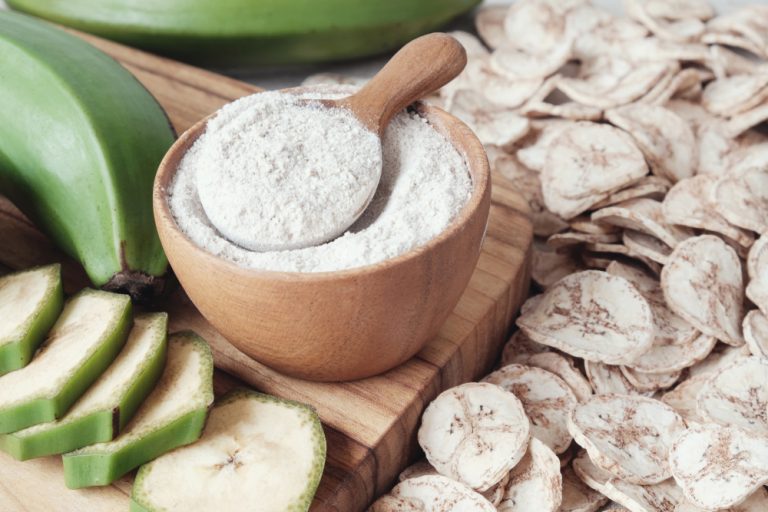Resistant starch is a carbohydrate that is resistant to digestive enzymes and passes unchanged into the large intestine. It is a breeding ground for the development of beneficial intestinal bacteria and has many health-promoting functions.
Resistant starch - what is it?
Resistant starch owes its name to the fact that it is not digested by gastrointestinal enzymes and is not absorbed in the small intestine. It is one of the components of dietary fibre. The resistance of raw potato starch to the action of amylolytic enzymes was first announced in 1937. The topic was revisited 40 years later, when Japanese researchers obtained similar results.
There are four types of resistant starch (RS).
RS1 - physically unavailable; starch contained in undamaged plant cells, e.g. whole cereal grains. It is indigestible in the digestive tract because it lacks enzymes that break down plant cell walls. It passes through the small intestine intact.
RS2 - raw starch grains found in some plants, e.g. raw potatoes, unripe bananas, legume seeds.
RS3 - Retrograded starch, which is formed in heat-treated and cooled afterward food products. It is a starch that has glued at an elevated temperature, i.e. became digestible for humans, and then precipitated during the retrogradation process. RS3 is found in cooled potatoes, rice, pasta, cereals and stale bread.
RS4 - Chemically or physically modified starch.
Resistant starch as a fibre
In the sense, insoluble fibre is a component of plant cell walls that is not digested in the gastrointestinal tract, such as cellulose, hemicellulose and lignin, and soluble fibre includes pectin.
Currently, the constituent of dietary fibre includes resistant starch because eating it has the same health benefits for the human body as eating other fibre components. Resistant starch has a soluble fibre effect.
It increases the volume of food content, passes through the small intestine in an unchanged form, and when it reaches the large intestine, it is fermented by bacteria of the Bifidobacterium and Lactobacillus species, i.e. probiotic lactic acid bacteria that are the basis of healthy human intestinal microflora. The benefits of using resistant starch as a prebiotic or nutrient solution for the proper gut microbiome include:
- production of short-chain fatty acids (acetic, propionic and butyric ones) which are used by intestinal cells as an energy and nutrient component and improve their functioning
- increased absorption of minerals, especially calcium and magnesium
- lowering the level of sugar and cholesterol in the blood
- reducing the risk of developing colorectal cancer
Food rich in resistant starch
Resistant starch as an ingredient beneficial to health should be consumed daily in an amount of at least 20 g per day. In developing countries, the average amount in the diet is 30-40 g, while in developed countries, including European Union countries, we consume on average only 3-6 g of resistant starch per day.
To avoid unpleasant gastrointestinal ailments, such as flatulence and diarrhea, you should not eat more than 50-60 g of resistant starch per day.
The best sources of resistant starch are
- beans - 8 g of resistant starch in 1/2 cup
- banana with a green skin - 6 g resistant starch in one large fruit
- wheat bran - 4.6 g resistant starch in 1/2 cup
- boiled lentils - 3.4 g resistant starch in 1/2 cup
- potatoes - 4 g resistant starch in 1/2 cup chilled
- brown rice - 3 g resistant starch in 1/2 cup chilled
- corn - 2 g resistant starch in 1/2 cup
- wholemeal bread - 1-2 g of resistant starch in 3 slices
Resistant starch - health properties
Much attention went to the resistant starch and its potential health effects in recent time. When consumed in adequate amounts, resistant starch has been shown to contribute to proper colon health, preventing inflammatory bowel disease, and protecting against colon cancer - the world’s fourth leading cause of death.
Resistant starch has a lower effect on lipid and glucose metabolism than non-starch polysaccharides, but nevertheless plays an important role in lowering cholesterol and blood sugar levels.
The prebiotic and pro-health potential of resistant starch is likely to be used in the food industry on a large scale in order to introduce this valuable ingredient in greater amounts into the diet of people in highly developed countries.
Resistant starch - role in slimming diets
Starch-rich carbohydrate products are the most calorific immediately after thermal processing, when the starch is most glued, and therefore most easily digestible.
The colder the potatoes or pasta, the more starch is retrograded, the proportion of resistant starch increases and the caloric content of the dish decreases. This can be used in weight loss diets and weight management.
To increase the amount of resistant starch in the menu, warm, carbohydrate-rich dishes can be replaced with potato or pasta salads, as well as desserts, for example made with the use of rice.








2 Comments